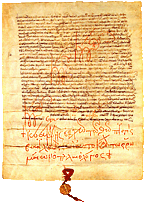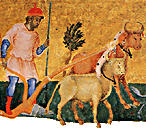 |
|
 |
The village
 he rural areas in the late Byzantine period present many characteristics
he rural areas in the late Byzantine period present many characteristics
 that do not differ substantially from those of previous periods. The village still remains the main form of social organisation. It is very difficult to determine with precision its size and population, as these were always dependent on the region and on the mobility of the population at particular periods of time. that do not differ substantially from those of previous periods. The village still remains the main form of social organisation. It is very difficult to determine with precision its size and population, as these were always dependent on the region and on the mobility of the population at particular periods of time.
Certain changes, however,
are the natural result of the different economic circumstances prevailing in the late Byzantine period. One should mention the concession of entire villages to one or more landowners, along with their lands, pastures, and the rights and obligations attached to them, a fact that could not but directly affect the life of the rural population. The Byzantine village functioned as a collective entity with respect to the landowner when it came to important financial and legal matters. The farmer's property was situated, more often than not, in the environs of his village, while he often also possessed a vineyard and a market garden, depending on his financial
 situation. The life of the peasants was centred around the church and the family, which constituted the core of their social life. situation. The life of the peasants was centred around the church and the family, which constituted the core of their social life.
The most important occupation of the rural
population was agriculture, but they also engaged in cattle-breeding,
apiculture, fishing, as well as in the cultivation of the vine and of
various fruit trees. We can imagine the cultures and the crops produced as
virtually the same as those of today, with the exception of certain crops
that were unknown at the time, such as tobacco. The majority of households
appear to have posessed no animals or only very few, in contrast to the
great landowners, who owned huge herds. Suffice it to mention that, in
1300, out of 130 households of the village of Gomato in Macedonia, 8
owned 928 animals between them, a number in striking contrast with
the 70,000 sheep and numerous other animals which John Kantakouzenos
claimed to have lost during the civil war.
|